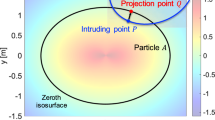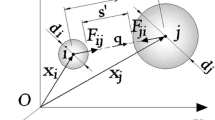Abstract
The main objective of this research is to formulate and couple technologies for modeling discrete and continuous media using real particle morphologies. To that end, two coupled formulations based on virtual modeling technologies of single real particles with another one called real particle packing technique are presented. The first formulation employs Fourier descriptors’ theory to virtually achieve the morphology and construct a repository of real particle geometries. The second formulation is a particle packing method, supported by advancing front techniques combined with dynamic methods. This method presents a stochastic formulation and allows the packing of particle systems following continuous, discrete and empirical statistical distributions. The coupling of both techniques is a very efficient tool to achieve discrete or continuous media geometries to solve engineering problems. Three different examples are developed to illustrate the usefulness of the formulations. The first one is a discrete angle-of-repose problem involving clusters of spheres (real particle morphologies are described with groups of spheres); in the second example the same angle-of-repose problem is resolved with real particles. In the third case, which involves continuous medium mechanics, a small-scale road engineering problem is modeled, specifically, the testing of an asphalt concrete.





























Similar content being viewed by others
References
Xu MQ, Guo N, Yang ZX (2021) Particle shape effects on the shear behaviors of granular assemblies: irregularity and elongation. Granul Matter 23:25. https://doi.org/10.1007/s10035-021-01096-4
Richard P, Edil TB, Bosscher PJ, Plesha ME, Kahla NB (2001) Effect of particle shape on interface behavior of DEM-simulated granular materials. Int J Geomech 1(1):1–19
Xie YH, Yang ZX, Barreto D et al (2017) The influence of particle geometry and the intermediate stress ratio on the shear behavior of granular materials. Granul Matter 19:35. https://doi.org/10.1007/s10035-017-0723-8
Irazábal J, Salazar F, Oñate E (2017) Numerical modelling of granular materials with spherical discrete particles and the bounded rolling friction model. Application to railway ballast. Comput Geotech 85:220–229
Fu P, Dafalias Y (2011) Fabric evolution within shear bands of granular materials and its relation to critical state theory. Int J Num Anal Meth Geomech 35(18):1918–1948
Lin X, Ng TT (1997) A three-dimensional discrete element model using arrays of ellipsoids. Geotechnique 47(2):319–329
Ng T-T (2009) Particle shape effect on macro- and micro-behavior of monodisperse ellipsoids. Int J Num Anal Meth Geomech 33:511–527
Ouadfel H, Rothenburg L (2001) “Stress-force fabric” relationship for assemblies of ellipsoids. Mech Mater 33:201–221
Pournin L, Weber M, Tsukahara M, Ferrez J-A, Ramaioli M, Liebling TM (2005) Three-dimensional distinct element simulation of spherocylinder crystallization. Granular Matter 7(2):119–126
Tillemans H-J, Herrmann H-J (1995) Simulating deformations of granular solids under shear. Phys Rev A 217:261–288
Pena AA, Garcia-Rojo R, Herrmann HJ (2007) Influence of particle shape on sheared dense granular media. Granular Matter 9:279–291
Lu M, McDowell GR (2007) The importance of modelling ballast particle shape in DEM. Granul Matter 9(2):71–82
Azema E, Radjai F, Saussine G (2009) Quasistatic rheology, force transmission and fabric properties of a packing of irregular polyhedral particles. Mech Mater 41:729–741
Galindo-Torres S-A, Pedroso D-M (2010) Molecular dynamics simulations of complex-shaped particles using Voronoi-based spheropolyhedra. Phys Rev E 81:061303
Galindo-Torres S-A, Munoz J-D, Alonso-Marroquin F (2010) Minkowski-Voronoi diagrams as a method to generate random packing of spheropolygons for the simulation of soils. Phys Rev E 82:056713
Richefeu V, Mollon G, Daudon D, Villard P (2012) Dissipative contacts and realistic block shapes for modelling rock avalanches. Eng Geol 19(150):78–92
Mollon G, Richefeu V, Villard P, Daudon D (2013) Numerical simulation of rock avalanches: influence of a local dissipative contact model on the collective behavior of granular flows. J Geophys Res Solid Earth 117:F02036
Al Rousan TM (2004) Characterization of aggregate shape properties using a computer automated system. PhD Dissertation. December
Mollon G, Zhao J (2013) Generating realistic 3D sand particles using Fourier descriptors. Granul Matter 15(1):95–108
Recarey Morfa CA, Rosello Valera R, Castro Fuentes M, Pena Águila J (2019) Formulación de tecnologías de modelación virtual de partículas soportadas en técnicas de estocasticidad. Proyectos de Investigación 95634, Ministerio de la Construcción. República de Cuba. Informe Técnico del Proyectos 2019
Mollon G, Zhao J (2012) Fourier-Voronoi-based generation of realistic samples for discrete modelling of granular materials. Granul Matter 2012(14):621–638. https://doi.org/10.1007/s10035-012-0356-x
Mollon G, Zhao J (2014) 3D generation of realistic granular samples based on random fields theory and Fourier Shape Descriptors. Comput Methods Appl Mech Eng 279(2014):46–65. https://doi.org/10.1016/j.cma.2014.06.022
Morales IP et al (2009) Procedimiento de empaquetamiento de partículas genéricas para el Método de Elementos Discretos. Revista Internacional de Métodos Numéricos para Cálculo y Diseño en Ingeniería 25(2):95–110
Morales IP et al (2016) Contributions to the generalization of advancing front particle packing algorithms. Int J Numer Methods Eng 107(12):993–1008
PérezMorales I et al (2017) Dense packing of general-shaped particles using a minimization technique. Comput Part Mech 4(2):165–179
Recarey C, Pérez I, Roselló R, Muniz M, Hernández E, Giraldo R, Oñate E (2019) Advances in particle packing algorithms for generating the medium in the discrete element method. Comput Methods Appl Mech Eng 345:336–362. https://doi.org/10.1016/j.cma.2018.11.011
Shi C, Shen J, Xu W et al (2017) Micromorphological characterization and random reconstruction of 3D particles based on spherical harmonic analysis. J Cent South Univ 24:1197–1206. https://doi.org/10.1007/s11771-017-3523-8
Brechbühler C, Gerig G, Kübler O (1995) Parametrization of closed surfaces for 3-D shape description. Comput Vis Image Underst 61(2):154–170
Wei D, Wang J, Zhao B (2018) A simple method for particle shape generation with spherical harmonics. Powder Technol 330:284–291
Feng YT, Han K, Owen DRJ (2003) Filling domains with disks: an advancing front approach. Int J Numer Methods Eng 56:699–713
Benabbou A et al (2009) Geometrical modelling of granular structures in two and three dimensions. Application to nanostructures. Int J Numer Methods Eng 80(4):425–454
Zarowski CJ (2004) An introduction to numerical analysis for electrical and computer engineers. Wiley
Möller T, Haines E, Peters AK (1999) Real-time rendering. A. K. Peters
Gottschalk S, Lin MC, Manocha D Technical report TR96-013, Department of Computer Science, University of North Carolina, Chapel Hill. In: Proceedings of ACM Siggraph’96.
Gottschalk S, Larsen E Proximity query package. UNC, Chapel Hill Computer Science. https://github.com/GammaUNC/PQP
Gottschalk S (1996) Separating axis theorem. Technical Report TR96-024, Department of Computer Science, UNC Chapel Hill
Wensrich CM, Katterfeld A (2012) Rolling friction as a technique for modelling particle shape in DEM. Powder Technol 217:409–417
Lane JE, Metzger PT, Wilkinson RA (2010) A review of discrete element method (DEM) particle shapes and size distributions for lunar soil. Technical report NASA
Lu G, Third JR, Müller CR (2015) Discrete element models for non-spherical particle systems: from theoretical developments to applications. Chem Eng Sci 127:425–465
Thomas PA, Bray JD (1999) Capturing nonspherical shape of granular media with disk clusters. J Geotech Geoenviron Eng 125:169–178
Ferellec J-F, McDowell G (2010) A method to model realistic particle shape and inertia in DEM. Granul Matter 12:459–467
Mollon G, Zhao J (2013) Characterization of fluctuations in granular hopper flows. Granul Matter 15(6):827–840
Jensen RP, Edil TB, Bosscher PJ, Plesha ME, Ben Kahla N (2001) Effect of particle shape on interface behavior of DEM-simulated granular materials. Int J Geomech 1(1):1–19
Stahl M, Konietzky H (2011) Discrete element simulation of ballast and gravel under special consideration of grain-shape, grain-size and relative density. Granul Matter 13:417–428
Katagiri J, Matsushima T, Yamada Y (2010) Simple shear simulation of 3D irregularly-shaped particles by image-based DEM. Granul Matter 12:491–497
Matsushima T, Katagiri J, Uesugi K, Tsuchiyama A, Nakano T (2009) 3D shapes characterization and image-based DEM simulation of the Lunar soil simulant FJS-1. J Aerosp Eng 22(1):15–23
McDowel G, Li H, Lowndes I (2011) The importance of particle shape in discrete-element modelling of particle flow in a chute. Geotech Lett 1(3):59–64
Chen C, McDowell GR, Thom NH (2014) Investigating geogrid-reinforced ballast: Experimental pull-out tests and discrete element modelling. In: Soils and foundations. Special issue on 2nd international conference on transportation geotechnics IS-Hokkaido2012, vol 54, no 1, pp 1–11
García X, Xiang J, Latham JP, Harrison JP (2009) A clustered overlapping sphere algorithm to represent real particles in discrete element modelling. Géotechnique 59(9):779–784
Ngo NT, Indraratna B, Rujikiatkamjorn C (2014) DEM simulation of the behaviour of geogrid stabilised ballast fouled with coal. Comput Geotech 55:224–231
Indraratna B, Ngo NT, Rujikiatkamjorn C, Vinod JS (2014) Behavior of fresh and fouled railway ballast subjected to direct shear testing: discrete element simulation. Int J Geomech 14(1):34–44
Irazábal González J (2017) Numerical analysis of railway ballast behaviour using the Discrete Element Method. PhD dissertation thesis. Departament d’Enginyeria Civil i Ambiental, Escola Tècnica Superior d’Enginyers de Camins, Canals i Ports de Barcelona, Universitat Politècnica de Catalunya
Dadvand P, Rossi R, Oñate E (2010) An object-oriented environment for developing finite element codes for multi-disciplinary applications. Arch Comput Methods Eng 17(3):253–297
Taylor DW (1948) Fundamentals of soil mechanics. Wiley
Recarey Morfa CA, Rosello Valera R, Castro Fuentes M, Pena Águila J (2019) Formulación del método de los elementos discretos para partículas reales. Proyectos de Investigación 98944, Ministerio de la Construcción. República de Cuba. Informe Técnico del Proyectos
Oliveira Junior M (2018) Análise Numérica De Fluência Estática De Misturas Asfálticas Via Mef: Estudo Da Fase Agregados Graúdo. Dissertação De Mestrado Em Geotecnia. Publicação: G.Dm-311/18. Universidade de Brasília
Oliveira Junior M, Farias MM (2020) A simple numerical methodology to simulate creep tests in HMA. Constr. Build. Mater. 262
Oliveira Junior M, Farias MM, Recarey Morfa CA (2020) A numerical study of the influence of aggregates shape on cree and recovery tests behavior. In: RILEM international symposium on bituminous materials (ISBM Lyon)
Farmer IW (1968) Engineering behaviour of rocks. Chapman and Hall Ltd., London
Acknowledgements
The authors are deeply grateful to the valuable funding, resources and support of the following institutions: Brazilian Electricity Regulatory Agency (ANEEL) e Furnas Centrais Elétricas S. A., Project P&D 0394-1709/2017 via Fundação de Empreendimentos Científicos e Tecnológicos, FINATEC e Project P&D PD-0394-1705/2017 via Fundação de Apoio a Pesquisa, FUNAPE; Conselho Nacional de Desenvolvimento Científico e Tecnológico (CNPq), Process No. 140938/2018-4; Doctoral Studies Commission of the Nueva Granada Military University, Bogotá, Colombia; International Center for Numerical Methods in Engineering, CIMNE, Barcelona, Spain.
Author information
Authors and Affiliations
Contributions
All authors contributed to the study conception and design. Material preparation and data collection were performed by RLRV, JIG, MdeOJ, MA and CARM. Real particle shape generation was performed by RLRV, MMdeF, MACF, JPA, LAMA and CARM. Particle packings of cluster of spheres and real particles were performed by RLRV, MMdeF, MACF, RTM, JPA and CARM. Micromechanical simulations and analysis of continuous media were performed by RLRV, MdeOJ, MMdeF and CARM. Discrete simulations and analysis with cluster of spheres were performed by JIG, EO, RLRV and CARM. The first draft of the manuscript was written by RLRV, and all authors commented on previous versions of the manuscript. All authors read and approved the final manuscript.
Corresponding author
Ethics declarations
Conflict of interest
The authors declare that they have no known competing financial interests or personal relationships that could have appeared to influence the work reported in this paper.
Additional information
Publisher's Note
Springer Nature remains neutral with regard to jurisdictional claims in published maps and institutional affiliations.
Rights and permissions
About this article
Cite this article
Valera, R.L.R., González, J.I., de Oliveira Junior, M. et al. Development and coupling of numerical techniques for modeling micromechanical discrete and continuous media using real particle morphologies. Comp. Part. Mech. 10, 121–141 (2023). https://doi.org/10.1007/s40571-022-00481-x
Received:
Revised:
Accepted:
Published:
Issue Date:
DOI: https://doi.org/10.1007/s40571-022-00481-x




